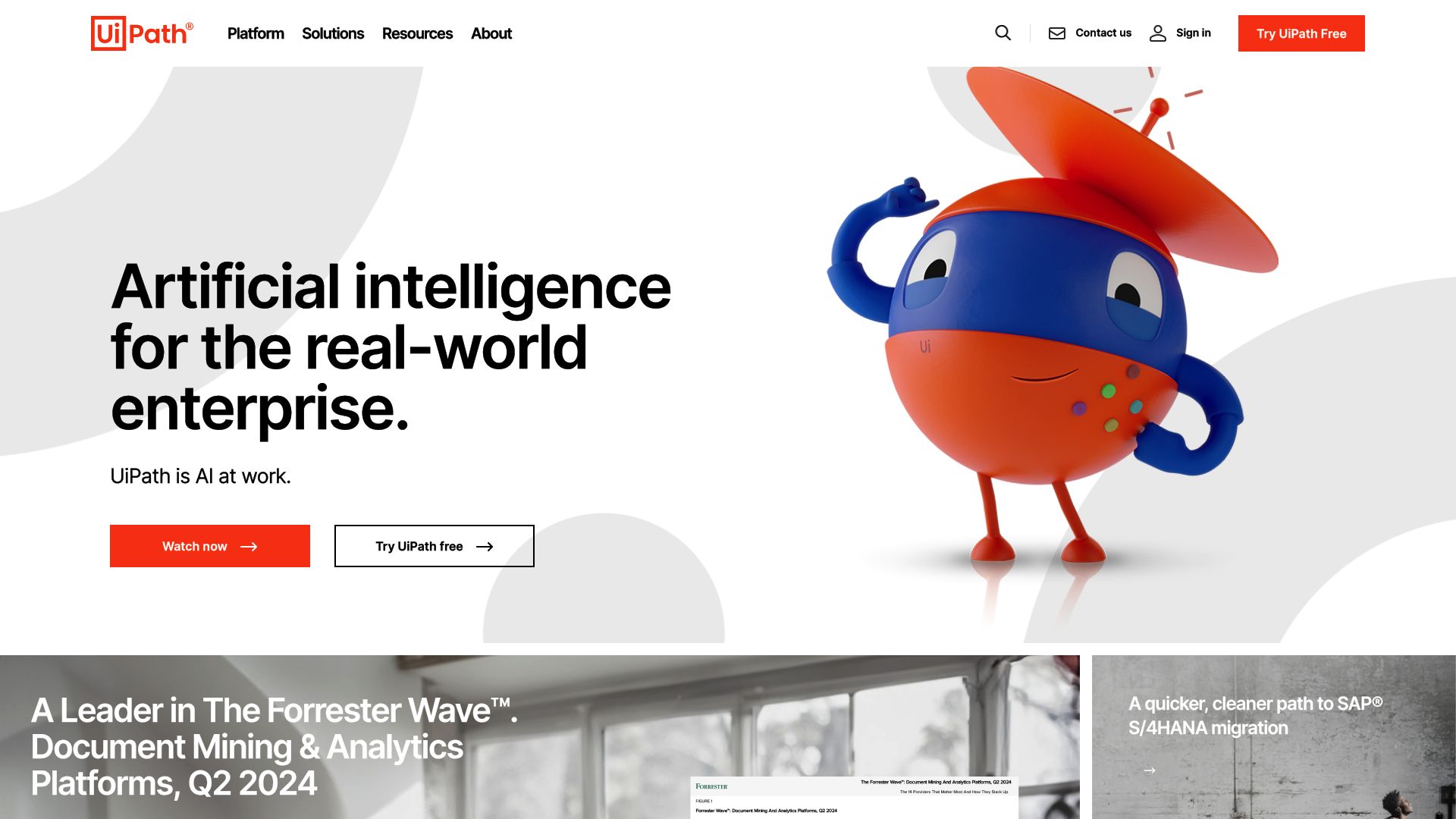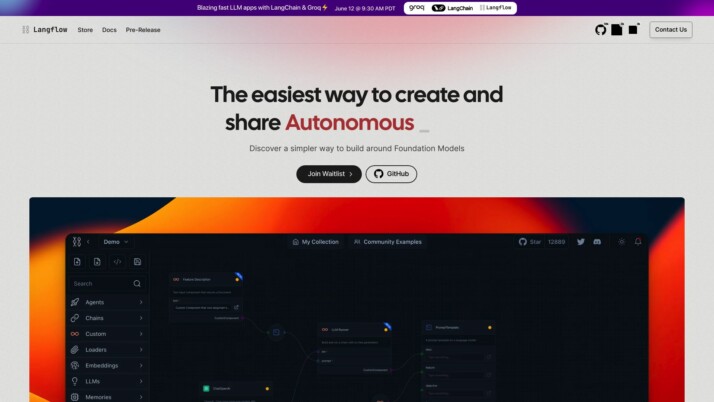AI and automation technologies revolutionize how businesses operate, but choosing the right platform can be daunting. This comparison examines UiPath vs. LangChain, and SmythOS, exploring their unique approaches to AI integration and process automation. UiPath leads in robotic process automation, while LangChain offers developers a flexible framework for language model applications. SmythOS emerges as a powerful alternative, combining ease of use with advanced AI capabilities. We’ll dive into each platform’s strengths, limitations, and ideal use cases, equipping you with the knowledge to select the best solution for your organization’s needs.
UiPath Overview
UiPath leads the robotic process automation (RPA) industry with its comprehensive enterprise automation platform. The company empowers organizations to streamline operations by automating repetitive tasks across departments. UiPath’s core product, the UiPath Platform, combines RPA capabilities with artificial intelligence to create intelligent software robots that can mimic human actions and decision-making processes.
The UiPath Platform excels in automating rule-based, repetitive tasks in industries like finance, healthcare, and manufacturing. It offers a visual development environment through UiPath Studio, allowing both developers and business users to create automation workflows without extensive coding knowledge. This approach democratizes automation, enabling a wider range of professionals to contribute to digital transformation initiatives.
UiPath’s core product, the UiPath Platform, combines RPA capabilities with artificial intelligence to create intelligent software robots that can mimic human actions and decision-making processes.
UiPath enhances its RPA foundation with AI capabilities through UiPath AI Center. This integration allows organizations to incorporate machine learning models into their automation workflows, enabling more complex decision-making and data processing tasks. The platform’s strengths lie in its scalability, robust governance features, and extensive integration capabilities with existing enterprise systems.

While UiPath offers powerful automation tools, users may face challenges in complex integrations with legacy systems or in scenarios requiring advanced AI capabilities beyond traditional RPA. The platform’s learning curve can be steep for organizations new to RPA, potentially requiring significant training and resources for effective implementation.
UiPath integrates seamlessly with a wide range of enterprise applications, databases, and cloud services. This interoperability allows organizations to create end-to-end automation solutions that span multiple systems and departments. The platform supports both attended and unattended automation, catering to front-office and back-office processes alike.
UiPath integrates seamlessly with a wide range of enterprise applications, databases, and cloud services.
In the competitive RPA landscape, UiPath distinguishes itself through its comprehensive feature set, strong market presence, and continuous innovation in AI-enhanced automation. However, organizations should carefully assess their specific automation needs and technical capabilities to determine if UiPath aligns with their digital transformation goals and resources.
LangChain Overview
LangChain offers developers a versatile open-source framework for building applications powered by large language models (LLMs). The platform simplifies every stage of LLM application development, from initial coding to production deployment.
LangChain’s core strength lies in its comprehensive suite of tools and components. Developers can leverage pre-built modules for tasks like text generation, question answering, and document analysis. The framework also provides seamless integrations with popular LLM providers and external data sources, expanding the capabilities of AI-driven applications.
LangChain offers developers a versatile open-source framework for building applications powered by large language models (LLMs). The platform simplifies every stage of LLM application development…
LangChain excels in offering flexibility and customization options. Its modular architecture allows developers to mix and match components, creating tailored solutions for specific use cases. The platform supports advanced features like memory management, allowing AI agents to maintain context across conversations, and multi-agent collaboration for complex problem-solving scenarios.

While LangChain provides powerful tools, it requires a solid understanding of LLMs and Python programming. This learning curve may pose challenges for non-technical users or those new to AI development. Additionally, as an open-source project, enterprise-grade support and some advanced features found in commercial platforms may be limited.
LangChain’s ecosystem continues to evolve rapidly. The platform recently introduced LangGraph for building stateful, multi-actor applications, and LangSmith for debugging and monitoring LLM applications. These additions demonstrate LangChain’s commitment to providing developers with cutting-edge tools for AI application development.
LangChain’s ecosystem continues to evolve rapidly. The platform recently introduced LangGraph for building stateful, multi-actor applications, and LangSmith for debugging and monitoring LLM applications.
In the competitive landscape of AI development frameworks, LangChain stands out for its open-source nature, extensive documentation, and active community. While it may not offer the same level of out-of-the-box solutions as some commercial alternatives, LangChain’s flexibility and power make it an attractive choice for developers seeking granular control over their LLM-powered applications.
Feature Comparison
UiPath and LangChain offer distinct approaches to AI and automation, with significant feature gaps between them. UiPath excels in robotic process automation (RPA) with a comprehensive platform for automating repetitive tasks across enterprise systems. It provides visual development tools like UiPath Studio for creating automation workflows without extensive coding. In contrast, LangChain focuses on building applications powered by large language models (LLMs), offering a flexible framework for developers to create AI-driven solutions.
A key difference lies in their core components. UiPath centers on RPA capabilities, providing tools for process mining, task automation, and robot orchestration. It includes AI Center for integrating machine learning models into workflows. LangChain, however, emphasizes LLM application development, offering modules for tasks like text generation and question answering. LangChain’s modular architecture allows developers to customize AI solutions more granularly, while UiPath’s approach is more structured around business process automation.
Security features also differentiate the platforms. UiPath provides robust enterprise-grade security with features like data encryption, OAuth support, and detailed audit logs through its Orchestrator. LangChain, being an open-source framework, relies more on developers implementing their own security measures. While both platforms offer scalability, UiPath’s enterprise focus results in more comprehensive built-in governance and compliance tools, which may be particularly important for large organizations dealing with sensitive data.
Feature Comparison Table
| UiPath | LangChain | SmythOS | |
|---|---|---|---|
| CORE FEATURES | |||
| AI Agents | ❌ | ✅ | ✅ |
| Hosted Agents (Dev, Production) | ❌ | ✅ | ✅ |
| Visual Builder | ✅ | ❌ | ✅ |
| No-Code Options | ❌ | ❌ | ✅ |
| Memory & Context | ❌ | ✅ | ✅ |
| Autonomous Agents | ❌ | ✅ | ✅ |
| Explainability & Transparency | ❌ | ✅ | ✅ |
| Multimodal | ❌ | ✅ | ✅ |
| Problem-Solving Capabilities | ❌ | ✅ | ✅ |
| Multi-Agent Collaboration | ❌ | ✅ | ✅ |
| Work as Team | ❌ | ✅ | ✅ |
| Agent Work Scheduler | ✅ | ❌ | ✅ |
| SECURITY | |||
| Constrained Alignment | ❌ | ❌ | ✅ |
| IP Control | ✅ | ❌ | ✅ |
| COMPONENTS | |||
| Foundation AIs | ❌ | ✅ | ✅ |
| Huggingface AIs | ❌ | ✅ | ✅ |
| Zapier APIs | ❌ | ❌ | ✅ |
| Classifiers | ❌ | ✅ | ✅ |
| Data Lakes | ❌ | ❌ | ✅ |
| DEPLOYMENT OPTIONS (EMBODIMENTS) | |||
| Deploy as API | ❌ | ✅ | ✅ |
| Deploy as Webhook | ❌ | ❌ | ✅ |
| Staging Domains | ❌ | ❌ | ✅ |
| Production Domains | ❌ | ❌ | ✅ |
| Deploy as Site Chat | ❌ | ✅ | ✅ |
| Deploy as Scheduled Agent | ❌ | ❌ | ✅ |
| Deploy as GPT | ❌ | ✅ | ✅ |
| DATA LAKE SUPPORT | |||
| Hosted Vector Database | ❌ | ❌ | ✅ |
| Sitemap Crawler | ❌ | ❌ | ✅ |
| YouTube Transcript Crawler | ❌ | ❌ | ✅ |
| URL Crawler | ❌ | ❌ | ✅ |
| Word File Support | ✅ | ❌ | ✅ |
| TXT File Support | ❌ | ✅ | ✅ |
Best Alternative to UiPath and LangChain
SmythOS emerges as the superior alternative to UiPath and LangChain, offering a comprehensive agentic AI automation platform that addresses the limitations of both competitors. Our platform combines the best of both worlds, providing robust automation capabilities with advanced AI-powered features.
Unlike UiPath’s focus on traditional RPA and LangChain’s emphasis on LLM application development, SmythOS delivers a versatile solution that caters to a wide range of use cases. We offer an intuitive drag-and-drop interface that simplifies the creation of complex AI workflows, making advanced AI functionalities accessible to users with varying levels of technical expertise.
SmythOS delivers a versatile solution that caters to a wide range of use cases… making advanced AI functionalities accessible to users with varying levels of technical expertise.
SmythOS stands out with its extensive integration ecosystem, supporting APIs, AI models, and tools from various providers. This flexibility ensures seamless incorporation into existing workflows and business processes. Our pre-built API integrations and templates significantly reduce setup time, allowing users to focus on innovation rather than implementation details.
One of the key advantages of SmythOS is our support for multi-agent orchestration. While UiPath lacks this capability and LangChain offers limited collaboration features, we enable the creation of sophisticated multi-agent systems that can tackle complex tasks cooperatively. This feature enhances the efficiency and scalability of AI implementations, opening up new possibilities for automation and problem-solving.
Security and deployment options set SmythOS apart from the competition. We provide robust enterprise-grade security features, including data encryption, OAuth support, and IP control, addressing the concerns of large organizations dealing with sensitive data. Our platform offers versatile deployment options, allowing users to deploy agents as APIs, webhooks, site chats, or even as ChatGPT plugins. This flexibility ensures that AI solutions can be seamlessly integrated into existing systems, regardless of the specific requirements or constraints.
Conclusion
UiPath, LangChain, and SmythOS each offer unique approaches to AI and automation, catering to different needs and skill levels. UiPath excels in enterprise-grade robotic process automation, providing comprehensive tools for automating repetitive tasks across organizations. LangChain offers a flexible, open-source framework for developers to build sophisticated language model applications. However, SmythOS emerges as the superior choice for businesses seeking a versatile, user-friendly AI development platform.
SmythOS stands out with its intuitive drag-and-drop interface, making AI agent creation accessible to users without extensive coding knowledge. Unlike UiPath’s focus on structured workflows or LangChain’s developer-centric approach, SmythOS offers a balance of power and simplicity. It supports a vast array of integrations, including over 300,000 APIs and multiple AI models, surpassing the integration capabilities of both UiPath and LangChain.
Furthermore, SmythOS’s ’Create Once, Deploy Anywhere’ philosophy sets it apart, allowing users to deploy AI agents across various platforms seamlessly. This versatility, combined with features like multi-agent orchestration and advanced security measures, makes SmythOS an ideal choice for businesses looking to leverage AI effectively.
For those ready to experience the future of AI development, we invite you to explore our diverse range of AI-powered agent templates and get started with SmythOS. Our platform offers a risk-free opportunity to create unlimited AI agents, empowering you to transform your workflow and unlock new levels of productivity. Dive into the world of SmythOS and discover how our comprehensive solution can revolutionize your approach to AI integration and automation.